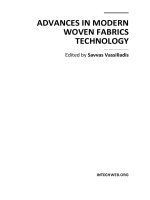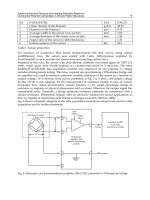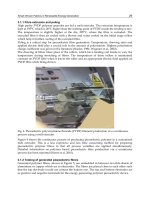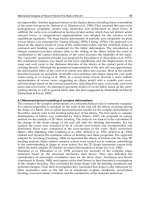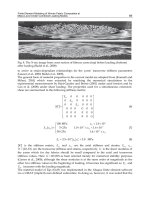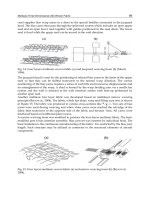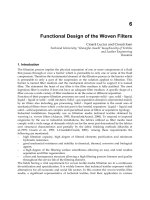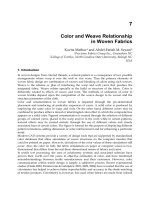Advances in Modern Woven Fabrics Technology Part 1 pdf
Bạn đang xem bản rút gọn của tài liệu. Xem và tải ngay bản đầy đủ của tài liệu tại đây (710.53 KB, 20 trang )
ADVANCES IN MODERN
WOVEN FABRICS
TECHNOLOGY
Edited by Savvas Vassiliadis
Advances in Modern Woven Fabrics Technology
Edited by Savvas Vassiliadis
Published by InTech
Janeza Trdine 9, 51000 Rijeka, Croatia
Copyright © 2011 InTech
All chapters are Open Access articles distributed under the Creative Commons
Non Commercial Share Alike Attribution 3.0 license, which permits to copy,
distribute, transmit, and adapt the work in any medium, so long as the original
work is properly cited. After this work has been published by InTech, authors
have the right to republish it, in whole or part, in any publication of which they
are the author, and to make other personal use of the work. Any republication,
referencing or personal use of the work must explicitly identify the original source.
Statements and opinions expressed in the chapters are these of the individual contributors
and not necessarily those of the editors or publisher. No responsibility is accepted
for the accuracy of information contained in the published articles. The publisher
assumes no responsibility for any damage or injury to persons or property arising out
of the use of any materials, instructions, methods or ideas contained in the book.
Publishing Process Manager Niksa Mandic
Technical Editor Teodora Smiljanic
Cover Designer Jan Hyrat
Image Copyright meirion matthias, 2010. Used under license from Shutterstock.com
First published July, 2011
Printed in Croatia
A free online edition of this book is available at www.intechopen.com
Additional hard copies can be obtained from
Advances in Modern Woven Fabrics Technology, Edited by Savvas Vassiliadis
p. cm.
ISBN 978-953-307-337-8
free online editions of InTech
Books and Journals can be found at
www.intechopen.com
Contents
Preface IX
Part 1 Multifunctional Woven Fabrics 1
Chapter 1 Electro-Conductive Sensors and Heating
Elements Based on Conductive Polymer
Composites in Woven Fabric Structures 3
Irina Cristian, Saad Nauman, Cédric Cochrane
and Vladan Koncar
Chapter 2 Smart Woven Fabrics in Renewable Energy Generation 23
Derman Vatansever, Elias Siores,
Ravi L. Hadimani and Tahir Shah
Part 2 Computational Modelling and Structural Woven Fabrics 39
Chapter 3 Mechanical Analysis of Woven Fabrics:
The State of the Art 41
Savvas Vassiliadis, Argyro Kallivretaki,
Dimitra Domvoglou and Christofer Provatidis
Chapter 4 Finite Element Modeling
of Woven Fabric Composites at Meso-Level
Under Combined Loading Modes 65
Mojtaba Komeili and Abbas S. Milani
Chapter 5 Multiaxis Three Dimensional (3D) Woven Fabric 79
Kadir Bilisik
Part 3 Design and Appearance of Woven Fabrics 107
Chapter 6 Functional Design of the Woven Filters 109
Cioară Lucica and Cioară Ioan
Chapter 7 Color and Weave Relationship in Woven Fabrics 129
Kavita Mathur and Abdel-Fattah M. Seyam
VI Contents
Part 4 Advanced Properties of Woven Fabrics 151
Chapter 8 Sensory and Physiological Issue 153
Laurence Schacher, Sourour Bensaid, Selsabil El-Ghezal Jeguirim
and Dominique Adolphe
Chapter 9 Superhydrophobic Superoleophobic Woven Fabrics 179
Hoonjoo Lee and Jeffery Owens
Chapter 10 The Flame Retardant Nomex/cotton
and Nylon/Cotton Blend Fabrics for Protective Clothing 197
Charles Q. Yang and Hui Yang
Chapter 11 Liquid Transport in Nylon 6.6. Woven Fabrics
Used for Outdoor Performance Clothing 211
A. B. Nyoni
Preface
Woven fabric: a simple structure, with complex properties and a unique behaviour! Two
sets of interlaced yarns, the warp and the weft, in various patterns result in this valuable
fibrous product. The woven fabrics are highly deformable, especially in bending and
shearing. Consequently, they were the only materials fulfilling the requirements of the
body protection, providing simultaneously a high level of comfort. The same basic
production principles are adopted from the time of the hand crafted production until
today for the industrialized products. The early use of the woven fabrics was mainly in
clothing and domestic applications. The so called technical applications in the past were
rare (sails, tents etc). Gradually, more and more technical applications appeared. In the
last period an explosive use of the woven fabrics in new application fields is being
observed. In parallel to the common traditional clothing and domestic commodities, very
important high value added technical products have been designed and produced.
Currently, the use of woven fabrics is being continuously expanded in fields including
medical, military, structural, telecommunications, electronic, aerospace etc. applications.
Thus the importance of the woven fabrics increases constantly. The specific and critical
character of the technical applications imposed a dynamic change in the fields of the
design, engineering, production and testing. The traditional empirical approach has been
replaced by the careful modelling, calculation of the properties, prediction of the
behaviour and the final evaluation of the performance. The modern approach is reflected
on the majority of the recent research results, the patents and the scientific publications
of the academic and industrial research community.
The new technological position and role of the woven fabrics causes important
changes and evolutions in some key fields. Therefore the four sections of the current
book correspond to the most influenced thematic areas:
Multifunctional character
Computational modelling and structural elements
Design and appearance
Advanced properties
The first section focused on the multifunctional character of the woven fabrics consists
of two chapters. The heat sensors and the heating elements based on the use of
conductive fibres, incorporated in woven fabrics are presented in the first chapter. The
X Preface
important issue of the energy harvesting is the topic covered by the second chapter.
Piezoelectric fibres are used in woven fabrics and their imposed mechanical
deformations result in the generation of electrical power.
The second section consists of three chapters and deals with the computational
modelling and structural elements. Chapter three comprises a thorough examination
of the mechanical modelling of the woven fabrics and leads to the state-of-the-art of
the computational mechanical modelling in various scales. The use of the finite
elements method for the prediction of the mechanical behaviour of woven fabric
composites at meso-level and under combined loading modes, is the subject of the
fourth chapter. The overview of the production methods and the classification of the
multiaxis three-dimensional fabrics are the subject of the fifth chapter.
The third section contains three chapters and includes design and appearance issues. The
computer supported functional design of the woven filters with the respective
applications are presented in the sixth chapter. The automatic recognition of the woven
fabrics based on the computational image processing method of the texture analysis is
the subject of the seventh chapter. The eighth chapter involves the examination of the
color and weave design relationship in woven fabrics made from colored yarns.
The fourth section, about the advanced properties of woven fabrics, consists of four
chapters. The sensory and physiological issues as major and strategic design factors
involving artificial neural networks and fuzzy logic tools is the topic of the ninth
chapter of the book. In the tenth chapter is presented a theoretical and practical
approach of the super-hydrophobic and super-oleophovic woven fabrics. The
finishing techniques for the production of flame retardant Nomex/cotton, nylon/cotton
and polyester/cotton blend fabrics for protective clothing is described in chapter
eleven. In the twelfth chapter exists the presentation of the liquid transport issues for
Nylon 6.6 woven fabrics used for outdoor performance clothing.
The authors of the twelve chapters are widely known for their expertise. They have
been invited to contribute in this book because of their international reputation in their
particular fields. Every single chapter though has a pioneering and innovative
character corresponding to the respective state-of-the-art. The result is a highly
interdisciplinary book with breaking through contents.
From the current position, I would like to thank the authors for their valuable
contribution, prompt response and cooperation during the preparation of the book.
The open access publishing principle is a new and powerful tool for the free and
worldwide dissemination of the scientific knowledge. I wish and hope that the current
open access book will serve better and more efficiently the future readers.
Savvas G. Vassiliadis
TEI Piraeus
Greece
Part 1
Multifunctional Woven Fabrics
1
Electro-Conductive Sensors and Heating
Elements Based on Conductive Polymer
Composites in Woven Fabric Structures
Irina Cristian
1,2,3
, Saad Nauman
1,2
,
Cédric Cochrane
1,2
and Vladan Koncar
1,2
1
University Lille Nord de France
2
ENSAIT, GEMTEX, F-59100 Roubaix
3
Technical University GHEORGHE ASACHI of Iaşi
1,2
France
3
Romania
1. Introduction
The use of intelligent materials which are capable of reacting to external stimuli is growing
in the field of textiles. Conductive materials, metals as well as conducting polymers, are
already being used in many textile applications, like antistatic materials, electromagnetic
interference shielding, heating, transport of electrical signals, sensors etc.
Conductive polymers are some of the developments which seem to respond to specific
properties of textile materials, like flexibility and deformability. Two sub-classes of
conductive polymers can be identified: intrinsically conductive polymers and conductive
polymer composites.
Inherently conducting polymers are composed of polymer chains containing long
conjugated double bonds which give rise to highly conducting properties, and they have
been considered as promising materials (Heeger, 2002; Kumar et al., 1998). Inherently
conducting polymers are suitable for applications in many domains of intelligent textiles,
but they present some substantial disadvantages, like infusibility or insolubility in common
organic solvents, weak mechanical properties and poor procesability. However, advanced
solution processing of this class of polymers has been developed significantly over the last
decade to improve their low solubility. For example, chemical modification of monomers
with dopants has enhanced the solubility in the case of polythiophene and polyaniline
(Haba et al., 1999; Gettinger et al., 1995).
For their part, composite conductive polymers are obtained by blending (generally by melt
mixing) an insulating polymer matrix (thermoplastic or thermosetting plastic) with
conductive fillers like carbon black, carbon fibres or nanotubes, metallic particles or
conductive polymers. The presence of filler particles in the matrix may have a negative
impact on the mechanical properties of the final composite (Krupa et al., 2001; Novak et al.,
2002). Instead of this, the development in the field of composite conductive polymers seems
therefore to be a promising approach for intelligent textiles own to simplicity of preparing
and to their low cost.
Advances in Modern Woven Fabrics Technology
4
In this chapter, two applications (sensor and actuator) based on coating of textile
materials with conductive polymer composites are presented. Several different coating
techniques for intelligent textile structures exist - the one chosen for both applications was
developed in our laboratory (Cochrane et al., 2007, 2010) based on dispersed carbon black
particles (Printex® L6) in a polymer solution (Styren-Butadien-Styren or latex), using a
solvent.
In the first part of this chapter, a new approach of NDE (Non Destructive Evaluation) using
fibrous sensors inserted inside composite woven reinforcements during their weaving is
presented. The use of 3D woven fabrics as the reinforcing medium for composites is
becoming a popular choice, due to various advantages such as reduced cost and shorter
production cycle, greater design flexibility and superior mechanical properties (Kamiya et
al., 2000). Recently, these high performance composites reinforced with 3D structures have
found wide applications in various industrial areas such as aerospace, aircraft, automobile,
civil engineering etc. Good quality and reliability are basic requirements for advanced
composite structures which are often used under harsh environments. To improve their
performance, the cure monitoring of technological process is clearly necessary. At the same
time, in service NDE is also needed to keep these structures operating safely and reliably.
A novel flexible piezoresistive fibrous sensor has been developed and optimized for in situ
structural deformation sensing in carbon composites. Those sensors were inserted as weft in
3D-woven interlock reinforcement, during the weaving process on a special weaving loom.
The reinforcement was then impregnated in epoxy resin and was later subjected to quasi
static tensile loading. It was found that the sensor was able to detect deformations in the
composite structure until rupture since it was inserted together with reinforcing tows.
The morphological and electromechanical properties of the fibrous sensors have been
analyzed using tomography and yarn tensile strength tester. An appropriate data
acquisition module has also been developed and used for data acquisition and its further
treatment. The results obtained for carbon composite specimens under standard testing
conditions have validated in situ monitoring concept using our fibrous textile sensors.
The second part of this chapter presents a woven fabric containing an original heating
element. Textile actuators like heating fabrics can find applications in numerous and varied
fields such as sports, leisure, medical and automotive (Droval et al., 2005; El-Trantawy et al.,
2002). Usually actuators need heavy power supplies that are rarely flexible and lightweight
which badly affects wearability. Our heating element is designed to adapt to flexible
structures. Metallic yarns, used as electrodes are integrated in a woven structure in a comb-
teeth arrangement. These electrodes are connected to a power supply. A thin conductive
coating is applied on the fabric surface and on the electrode arrangement, in order to ensure
uniform heat distribution. The coating is a composite material based on aqueous latex
dispersed with carbon black as filler. The heating element (comb electrodes and electro-
conductive coating) can thus adopt the desired pattern. This is an important aspect of our
heating element as it allows integration of the heating element in various fabrics designed
for varied and diverse applications. In our research the distance between electrodes
remained unchanged, the only variable value being the percentage of filler. The results
regarding the power consumption and textile surface temperature for different filler content
were registered. From these results, optimum filler content for heating application was
defined. A thermal image of the heating fabric operating at low voltage is given, in order to
demonstrate the efficiency of our system. A more precise measurement of surface
temperature is thus possible. For applied voltage of 15 V, the maximum temperature gained
Electro-conductive Sensors and Heating Elements Based on
Conductive Polymer Composites in Woven Fabric Structures
5
was about 50 °C. The thermal image also demonstrates the homogeneity of heating
provided by our system. Potential applications of these self heating fabrics include garments
designed to provide thermal comfort and antifreeze safety.
2. Electro-conductive sensors for on-line measurements of structural
deformation in composites reinforced with 3D-woven fabrics
Weaving technique has been used for a long time in order to obtain technical textile
products for industrial applications. An important use of this technology is for the
manufacturing of 3D reinforcements using high performance fibres (carbon, glass, aramid
etc.). 3D reinforcement based composites, in combination with high-performance fibres, are
being increasingly used in the aerospace industry (Ko, 2007). Particular advantages of these
fabrics mentioned in the literature include better through the thickness properties, better out
of plane properties, high impact resistance, enhanced delamination resistance, resistance to
crack propagation, impact/fracture resistance, improved post impact mechanical properties,
damage tolerance, dimensional stability, ease of fabrication and minimal need of cutting, lay
up and joining.
Regarding these properties it can be safely concluded that 3D woven fabrics constitute the
most promising class of reinforcements for composite materials for high tech structural
applications. To improve their performance, the cure monitoring of technological process is
clearly necessary. At the same time, in-service non destructive evaluation is also needed to
keep these structures operating safely and reliably. Non destructive evaluation techniques
have been developed in the past including ultrasonic scanning, acoustic emission,
shearography, stimulated infrared thermography, fibre brag grating sensors and vibration
testing etc. (Black, 2009). The challenge today is to develop new low cost techniques which
can perform on-line structural health assessment starting from the manufacture of
composite structure to the real service of these structures in the field. Moreover, the non
destructive evaluation techniques have to be integrated in the design phase and sensors
should be inserted during the fabrication of composites, in order to improve accuracy and
reduce their costs. The classical non destructive evaluation techniques are difficult to adapt.
They are not well suited for on-line structural health monitoring, because of difficulties in
making in situ implementation.
One possible solution is to use intelligent textile materials and structures which provide real
possibility for on-line and in situ monitoring of structural integrity. Such intelligent
materials are made by coating or treating textile yarns, filaments or fabrics with
nanoparticles or conductive & semi-conductive polymers giving them special properties.
A review of piezoresistive sensing approaches already being applied to measure strain in
fabrics/composites shows that several sensing mechanisms exist (Dharap et al., 2004;
Lorussi et al., 2005; Scilingo et al., 2003; Fiedler et al., 2004). These approaches may be
categorized on the basis of manufacturing technology as nanotube networks, use of carbon
tows for self-sensing and semi-conductive coatings.
Nanotubes have been investigated in detail for use as sensing mechanisms, both for smart
textile applications and for structural health monitoring of composites. Significant challenges
still exist in their development, for example the efficient growth of macroscopic-length carbon
nanotubes, controlled growth of nanotubes on desired substrates, durability of nanotube based
sensors and actuators, effective dispersion in polymer matrices and their orientation.
Therefore, there is a need to develop both experimental and analytical techniques to bridge the
Advances in Modern Woven Fabrics Technology
6
nano and macro scales towards optimization so as to use nanotube networks as sensors inside
macroscale (fabric) or mesoscale (tow) composites (Li et al., 2005).
Carbon fibre reinforced composites offer a unique possibility of using carbon tows as
sensing network because of their conductivity. However such an approach can only be used
for conductive fibre based composites. Moreover, before applying such an approach for
structural health monitoring it is imperative to understand the deformation mechanism of
the reinforcement. Any anomaly in the deformation mechanism can threaten the sensing
mechanism’s validity and efficacy.
Concerning semi conductive coatings, they are easy to realize and can be made wash
resistant. Their use as percolation networks for sensing in structural health monitoring
applications is quite promising and needs to be further investigated.
Present study is aimed at designing, developing and optimizing piezoresistive fibrous
sensors realized from semi-conductive coatings, suited for composites structural parts
containing 3D reinforcement. Our sensors can be embedded inside the reinforcement during
weaving and they have all the characteristics of a traditional textile material (flexible,
lightweight and are capable of adopting the geometry of the reinforcement and become its
integral part).
Embedding such an intelligent piezoresistive sensor inside the reinforcement during
weaving process is the most convenient and cost effective way of insertion of a sensor for
structural health monitoring.
Development and optimization of such piezoresistive sensors has been carried out in order
to render them sensitive enough to measure in situ strains inside the composite part.
Sensitivity is important as the targeted application usually undergoes very low strains and
even such low strains and/or vibrations during the life time of composite parts are critical.
Often they are used in areas where structural integrity can not be compromised (aircraft
wings, bodies etc).
2.1 Sensor design and optimisation
As coating solution, the conductive polymer composite based on dispersion of carbon black
particles (Printex® L6) in polymer (Evoprene® 007) solution, using chloroform as a solvent
was chosen (Cochrane et al, 2007, 2010).
In order to characterize the sensitivity and adherence of the coating on different substrates, the
35 % carbon black solution was coated on different yarns (71 tex cotton spun yarns; 482.3 tex
polyethylene monofilament and 25 tex polyamide monofilament). Visual inspection of the
surfaces of the coated yarns shows that the coating is more uniform for synthetic
monofilaments compared to cotton yarns. The cotton yarns absorb the conductive solution,
which penetrates inside the pores and interstices much like a dye. This particular
phenomenon could be a source of non homogeneity in sensor electrical and mechanical
properties, as the spun yarn is non uniform as compared to filaments, the coating and thus
the resistivity achieved could be non uniform. Moreover the greatest inconvenience with
coated cotton spun yarns is their low sensitivity during the initial tensile loading phase.
The resistance values were measured on 12 coated samples of each variant using a
multimeter. The resistivities were then calculated using the yarn/filament fineness,
yarn/filament lengths and these measured resistance values. Fig. 1 gives a comparison of
calculated resistivity values of conductive layer deposited on different fibrous substrates. It
can be seen that coated polyethylene filaments show relatively lower dispersion of
resistivity as compared to coated poyamide filaments.
Electro-conductive Sensors and Heating Elements Based on
Conductive Polymer Composites in Woven Fabric Structures
7
Fig. 1. Resistivity values calculated for different substrates coated with 35 wt % carbon
black solution
In order to carry out tensile tests on coated yarns and monofilaments, MTS 1/2 tester was
used. Samples underwent quasi static tensile loading at a constant test speed of 5 mm/min.
For the purpose of electrical resistance variation measurement during the tensile testing, a
simple voltage divider circuit and Keithley KUSB-3100 data acquisition module were
employed. Fig. 2 shows some of the results for electrical resistance variation, expressed as
normalised resistance (ΔR/R) during tensile testing, obtained using different substrates for
coating.
Initial resistance of the coating on cotton yarns is much lower then monofilaments. But since
the cotton spun yarns are inherently irregular, the coatings obtained are not homogenous
and the results for different coated yarns vary widely in their response to tensile loading
(Fig. 2-a). Due to particular fineness of the polyamide monofilament it was found that slight
non homogeneity in coating on the surface can result in breakdown of conductive path as is
obvious from Fig. 2-b. As a result, the behaviour of polyamide is highly inconsistent.
Polyethylene monofilaments provide a reasonably good compromise as the substrate. The
coatings on polyethylene are easy to achieve due to good substrate/conductive solution
interfacial properties. As the curves in Fig. 2-c show, the polyethylene coatings are
reproducible as the curves for all the four samples are nearly identical as opposed to
polyamide and cotton. Therefore, polyethylene monofilament was chosen for sensor
development.
The two ends of the coated polyethylene filaments were additionally coated with silver
paint and fine copper wire was attached to the two ends with the help of this paint (as
Advances in Modern Woven Fabrics Technology
8
shown in the Fig. 3). In this way, secure connections were realized enabling the reduction of
the contact resistance to the minimum.
a) Cotton spun yarns b) Polyamide monofilaments
c) Polyethylene monofilaments
Fig. 2. Electrical resistance variation during tensile strength tests on different yarn and
filament substrates coated with 35 wt % carbon black solution
Fig. 3. Carbon black coated sensor with polyethylene substrate
Sensor structural and geometrical parameters along with initial electrical resistance are
shown in Table 1.


